Unveiling Antibiotic Resistance: Genome Sequencing of Streptomycin-Resistant Erwinia amylovora Isolate
Abstract
1. Introduction
2. Materials and Methods
2.1. Isolation and Culture of the Strains
2.2. Biological Characterization of EaSmR
2.2.1. Minimum Inhibitory Concentration
2.2.2. Growth Rate
2.2.3. Motility Assays
2.2.4. Biofilm Formation
2.2.5. Evaluation of Virulence
2.3. Genomic DNA Extraction, Sequencing, Assembly, and Annotation
2.4. Analysis of Single Nucleotide Variants (nsSNVs)
2.5. Statistical Analysis
3. Results
3.1. Biological Characterization of Streptomycin-Resistant Strain EaSmR
3.2. Genome Statistics of EaSmR
3.3. Genome Variants (nsSNVs)
4. Discussion
5. Conclusions
Supplementary Materials
Author Contributions
Funding
Data Availability Statement
Acknowledgments
Conflicts of Interest
References
- Vanneste, J.L. Fire Blight: The Disease and Its Causative Agent, Erwinia amylovora; CABI: Wallingford, UK, 2000. [Google Scholar]
- Gayder, S.; Parcey, M.; Castle, A.J.; Svircev, A.M. Host range of bacteriophages against a world-wide collection of Erwinia amylovora determined using a quantitative PCR assay. Viruses 2019, 11, 910. [Google Scholar] [CrossRef] [PubMed]
- Park, D.; Yu, J.; Oh, E.; Han, K.; Yea, M.; Lee, S.; Myung, I.; Shim, H.; Oh, C. First report of fire blight disease on Asian pear caused by Erwinia amylovora in Korea. Plant Dis. 2016, 100, 1946. [Google Scholar] [CrossRef]
- Ham, H.; Lee, Y.K.; Kong, H.G.; Hong, S.J.; Lee, K.J.; Oh, G.R.; Lee, M.H.; Lee, Y.H. Outbreak of fire blight of apple and Asian pear in 2015–2019 in Korea. Res. Plant Dis. 2020, 26, 222–228. [Google Scholar] [CrossRef]
- Jik Lee, H.; Woo Lee, S.; Suh, S.J.; Hyun, I.H. Recent spread and potential pathways for fire blight in South Korea. EPPO Bull. 2022, 52, 135–140. [Google Scholar] [CrossRef]
- Choi, J.H.; Kim, J.Y.; Park, D.H. Evidence of greater competitive fitness of Erwinia amylovora over E. pyrifoliae in Korean isolates. Plant Pathol. J. 2022, 38, 355. [Google Scholar] [CrossRef]
- Kim, Y.J.; Choi, H.S.; Park, D.H. Persistence and viable but non-culturable state induced by streptomycin in Erwinia amylovora. Front. Microbiol. 2024, 15, 1346300. [Google Scholar] [CrossRef]
- Jamar, L.; Lateur, M. Strategies to reduce copper use in organic apple production. In Proceedings of the I International Symposium on Organic Apple and Pear 737, Wolfville, NS, Canada, 28 February–2 March 2006; pp. 113–120. [Google Scholar]
- Montag, J.; Schreiber, L.; Schönherr, J. An in vitro study of the nature of protective activities of copper sulphate, copper hydroxide and copper oxide against conidia of Venturia inaequalis. J. Phytopathol. 2006, 154, 474–481. [Google Scholar] [CrossRef]
- Park, D.; Lee, Y.; Kim, J.; Cha, J.; Oh, C. Current status of fire blight caused by Erwinia amylovora and action for its management in Korea. J. Plant Pathol. 2017, 99, 59–63. [Google Scholar] [CrossRef]
- McManus, P.S.; Stockwell, V.O.; Sundin, G.W.; Jones, A.L. Antibiotic use in plant agriculture. Annu. Rev. Phytopathol. 2002, 40, 443–465. [Google Scholar] [CrossRef]
- Jimenez Madrid, A.M.; Ivey, M.L.L. An overview of streptomycin resistance in Erwinia amylovora from Ohio apple orchards. Plant Health Prog. 2023, 24, 56–61. [Google Scholar] [CrossRef]
- Tancos, K.; Villani, S.; Kuehne, S.; Borejsza Wysocka, E.; Breth, D.; Carol, J.; Aldwinckle, H.; Cox, K. Prevalence of streptomycin-resistant Erwinia amylovora in New York apple orchards. Plant Dis. 2016, 100, 802–809. [Google Scholar] [CrossRef] [PubMed]
- Miller, T.; Schroth, M. Monitoring the epiphytic population of Erwinia amylovora. Phytopathology 1972, 62, 1175–1182. [Google Scholar] [CrossRef]
- Coyier, D.; Covey, R. Tolerance of Erwinia amylovora to streptomycin sulfate in Oregon and Washington. Plant Dis. Rep. 1975, 69, 849–852. [Google Scholar]
- Manulis, S.; Zutra, D.; Kleitman, F.; Dror, O.; David, I.; Zilberstaine, M.; Shabi, E. Distribution of streptomycin-resistant strains of Erwinia amylovora in Israel and occurrence of blossom blight in the autumn. Phytoparasitica 1998, 26, 223–230. [Google Scholar] [CrossRef]
- de León Door, A.P.; Romo Chacón, A.; Acosta Muñiz, C. Detection of streptomycin resistance in Erwinia amylovora strains isolated from apple orchards in Chihuahua, Mexico. Eur. J. Plant Pathol. 2013, 137, 223–229. [Google Scholar] [CrossRef]
- Thomson, S.; Gouk, S.; Vanneste, J.; Hale, C.; Clark, R. The presence of streptomycin resistant strains of Erwinia amylovora in New Zealand. In Proceedings of the VI International Workshop on Fire Blight 338, Athens, Greece, 20–23 October 1992; pp. 223–230. [Google Scholar]
- El Goorani, M.; El Kasheir, H.; Shoeib, A.A.; Hassanein, F.M. Distribution of streptomycin resistant strains of Erwinia amylovora in Egypt during 1988. J. Phytopathol. 1989, 127, 69–74. [Google Scholar] [CrossRef]
- Chiou, C.S.; Jones, A. Molecular analysis of high-level streptomycin resistance in Erwinia amylovora. Phytopathology 1995, 85, 324–328. [Google Scholar] [CrossRef]
- Rezzonico, F.; Stockwell, V.O.; Duffy, B. Plant agricultural streptomycin formulations do not carry antibiotic resistance genes. Antimicrob. Agents Chemother. 2009, 53, 3173–3177. [Google Scholar] [CrossRef]
- McGhee, G.C.; Sundin, G.W. Erwinia amylovora CRISPR elements provide new tools for evaluating strain diversity and for microbial source tracking. PLoS ONE 2012, 7, e41706. [Google Scholar] [CrossRef]
- Escursell, M.M.; Roschi, A.; Smits, T.H.; Rezzonico, F. Characterization and direct molecular discrimination of rpsL mutations leading to high streptomycin resistance in Erwinia amylovora. J. Plant Pathol. 2021, 103, 99–108. [Google Scholar] [CrossRef]
- Kang, I.J.; Park, D.H.; Lee, Y.K.; Han, S.W.; Kwak, Y.S.; Oh, C.S. Complete genome sequence of Erwinia amylovora strain TS3128, a Korean strain isolated in an Asian pear orchard in 2015. Microbiol. Resour. Ann. 2021, 10, e0069421. [Google Scholar] [CrossRef] [PubMed]
- Myung, I.; Lee, J.; Yun, M.; Lee, Y.; Lee, Y.; Park, D.; Oh, C. Fire blight of apple, caused by Erwinia amylovora, a new disease in Korea. Plant Dis. 2016, 100, 1774. [Google Scholar] [CrossRef]
- Yuan, X.; Eldred, L.I.; Sundin, G.W. Exopolysaccharides amylovoran and levan contribute to sliding motility in the fire blight pathogen Erwinia amylovora. Environ. Microbiol. 2022, 24, 4738–4754. [Google Scholar] [CrossRef] [PubMed]
- Déziel, E.; Comeau, Y.; Villemur, R. Initiation of biofilm formation by Pseudomonas aeruginosa 57RP correlates with emergence of hyperpiliated and highly adherent phenotypic variants deficient in swimming, swarming, and twitching motilities. J. Bacteriol. 2001, 183, 1195–1204. [Google Scholar] [CrossRef]
- O‘Toole, G.A.; Pratt, L.A.; Watnick, P.I.; Newman, D.K.; Weaver, V.B.; Kolter, R. [6] Genetic approaches to study of biofilms. Methods Enzymol. 1999, 310, 91–109. [Google Scholar] [CrossRef]
- Walker, B.J.; Abeel, T.; Shea, T.; Priest, M.; Abouelliel, A.; Sakthikumar, S.; Cuomo, C.A.; Zeng, Q.; Wortman, J.; Young, S.K. Pilon: An integrated tool for comprehensive microbial variant detection and genome assembly improvement. PLoS ONE 2014, 9, e112963. [Google Scholar] [CrossRef]
- Seppey, M.; Manni, M.; Zdobnov, E.M. BUSCO: Assessing Genome Assembly and Annotation Completeness; Humana: New York, NY, USA, 2019; Volume 1962, pp. 227–245. [Google Scholar]
- Seemann, T. Prokka: Rapid prokaryotic genome annotation. Bioinformatics 2014, 30, 2068–2069. [Google Scholar] [CrossRef]
- Li, H. Aligning sequence reads, clone sequences and assembly contigs with BWA-MEM. arXiv 2013, arXiv:1303.3997. [Google Scholar] [CrossRef]
- Li, H.; Handsaker, B.; Wysoker, A.; Fennell, T.; Ruan, J.; Homer, N.; Marth, G.; Abecasis, G.; Durbin, R. The sequence alignment/map format and SAMtools. Bioinformatics 2009, 25, 2078–2079. [Google Scholar] [CrossRef]
- Ham, H.; Lee, K.J.; Hong, S.J.; Kong, H.G.; Lee, M.-H.; Kim, H.-R.; Lee, Y.H. Outbreak of fire blight of apple and pear and its characteristics in Korea in 2019. Res. Plant Dis. 2020, 26, 239–249. [Google Scholar] [CrossRef]
- Ham, H.; Oh, G.-R.; Lee, B.W.; Lee, Y.H.; Lee, Y.H. Changes of sensitivity to streptomycin in Erwinia amylovora isolated from 2019 to 2023 in Korea. Res. Plant Dis. 2024, 30, 199–205. [Google Scholar] [CrossRef]
- Nair, J.; Rouse, D.A.; Bai, G.H.; Morris, S.L. The rpsL gene and streptomycin resistance in single and multiple drug-resistant strains of Mycobacterium tuberculosis. Mol. Microbiol. 1993, 10, 521–527. [Google Scholar] [CrossRef] [PubMed]
- Springer, B.; Kidan, Y.G.; Prammananan, T.; Ellrott, K.; Böttger, E.C.; Sander, P. Mechanisms of streptomycin resistance: Selection of mutations in the 16S rRNA gene conferring resistance. Antimicrob. Agents Chemother. 2001, 45, 2877–2884. [Google Scholar] [CrossRef] [PubMed]
- Durão, P.; Balbontín, R.; Gordo, I. Evolutionary mechanisms shaping the maintenance of antibiotic resistance. Trends Microbiol. 2018, 26, 677–691. [Google Scholar] [CrossRef]
- Levin, B.R.; Perrot, V.; Walker, N. Compensatory mutations, antibiotic resistance and the population genetics of adaptive evolution in bacteria. Genetics 2000, 154, 985–997. [Google Scholar] [CrossRef]
- Koshla, O.; Lopatniuk, M.; Borys, O.; Misaki, Y.; Kravets, V.; Ostash, I.; Shemediuk, A.; Ochi, K.; Luzhetskyy, A.; Fedorenko, V. Genetically engineered rpsL merodiploidy impacts secondary metabolism and antibiotic resistance in Streptomyces. World J. Microbiol. Biotechnol. 2021, 37, 62. [Google Scholar] [CrossRef]
- Nishino, K.; Yamasaki, S.; Nakashima, R.; Zwama, M.; Hayashi-Nishino, M. Function and inhibitory mechanisms of multidrug efflux pumps. Front. Microbiol. 2021, 12, 737288. [Google Scholar] [CrossRef]
- Sjuts, H.; Vargiu, A.V.; Kwasny, S.M.; Nguyen, S.T.; Kim, H.S.; Ding, X.; Ornik, A.R.; Ruggerone, P.; Bowlin, T.L.; Nikaido, H. Molecular basis for inhibition of AcrB multidrug efflux pump by novel and powerful pyranopyridine derivatives. Proc. Natl. Acad. Sci. USA 2016, 113, 3509–3514. [Google Scholar] [CrossRef]
- Nishino, K.; Yamaguchi, A. Analysis of a complete library of putative drug transporter genes in Escherichia coli. J. Bacteriol. 2001, 183, 5803–5812. [Google Scholar] [CrossRef]
- Baker, J.; Wright, S.H.; Tama, F. Simulations of substrate transport in the multidrug transporter EmrD. Proteins 2012, 80, 1620–1632. [Google Scholar] [CrossRef]
- Salah Ud-Din, A.I.M.; Roujeinikova, A. Methyl-accepting chemotaxis proteins: A core sensing element in prokaryotes and archaea. Cell. Mol. Life Sci. 2017, 74, 3293–3303. [Google Scholar] [CrossRef] [PubMed]
- He, K.; Bauer, C.E. Chemosensory signaling systems that control bacterial survival. Trends Microbiol. 2014, 22, 389–398. [Google Scholar] [CrossRef] [PubMed]
- Black, W.P.; Yang, Z. Myxococcus Xanthus chemotaxis homologs DifD and DifG negatively regulate fibril polysaccharide production. J. Bacteriol. 2004, 186, 1001–1008. [Google Scholar] [CrossRef] [PubMed]
- Kaniga, K.; Bossio, J.C.; Galán, J.E. The Salmonella typhimurium invasion genes invF and invG encode homologues of the AraC and PulD family of proteins. Mol. Microbiol. 1994, 13, 555–568. [Google Scholar] [CrossRef]
- Västermark, Å.; Saier, M.H., Jr. The involvement of transport proteins in transcriptional and metabolic regulation. Curr. Opin. Microbiol. 2014, 18, 8–15. [Google Scholar] [CrossRef]
- Ward, B. Bacterial energy metabolism. In Molecular Medical Microbiology; Elsevier: Amsterdam, The Netherlands, 2015; pp. 201–233. [Google Scholar]
- Seip, B.; Innis, C.A. How widespread is metabolite sensing by ribosome-arresting nascent peptides? J. Mol. Biol. 2016, 428, 2217–2227. [Google Scholar] [CrossRef]
- Jansen, G.; Mahrt, N.; Tueffers, L.; Barbosa, C.; Harjes, M.; Adolph, G.; Friedrichs, A.; Krenz-Weinreich, A.; Rosenstiel, P.; Schulenburg, H. Association between clinical antibiotic resistance and susceptibility of Pseudomonas in the cystic fibrosis lung. Evol. Med. Public Health 2016, 2016, 182–194. [Google Scholar] [CrossRef]
- Baker, M.D.; Wolanin, P.M.; Stock, J.B. Signal transduction in bacterial chemotaxis. Bioessays 2006, 28, 9–22. [Google Scholar] [CrossRef]
- Colin, R.; Ni, B.; Laganenka, L.; Sourjik, V. Multiple functions of flagellar motility and chemotaxis in bacterial physiology. FEMS Microbiol. Rev. 2021, 45, fuab038. [Google Scholar] [CrossRef]
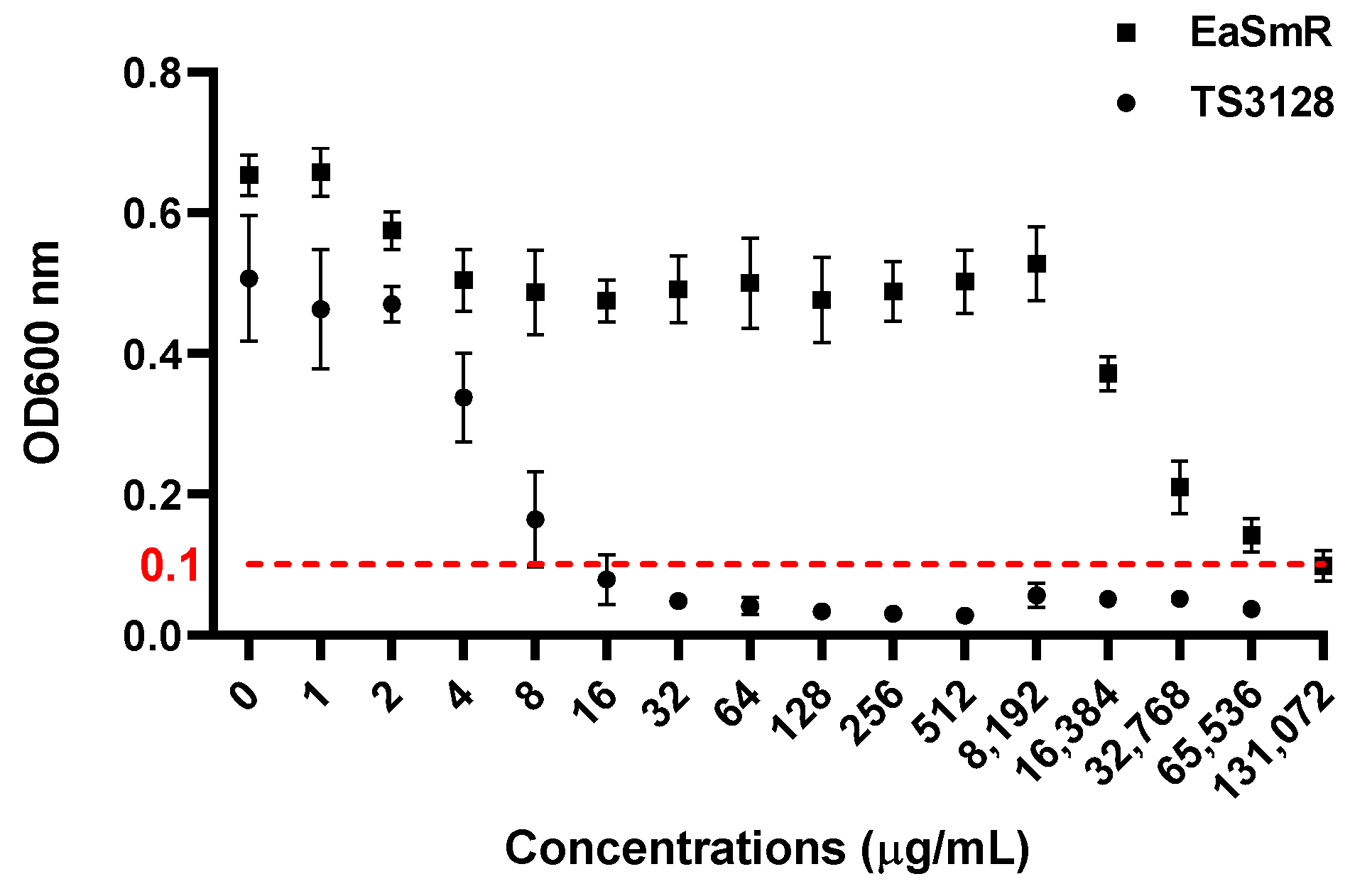
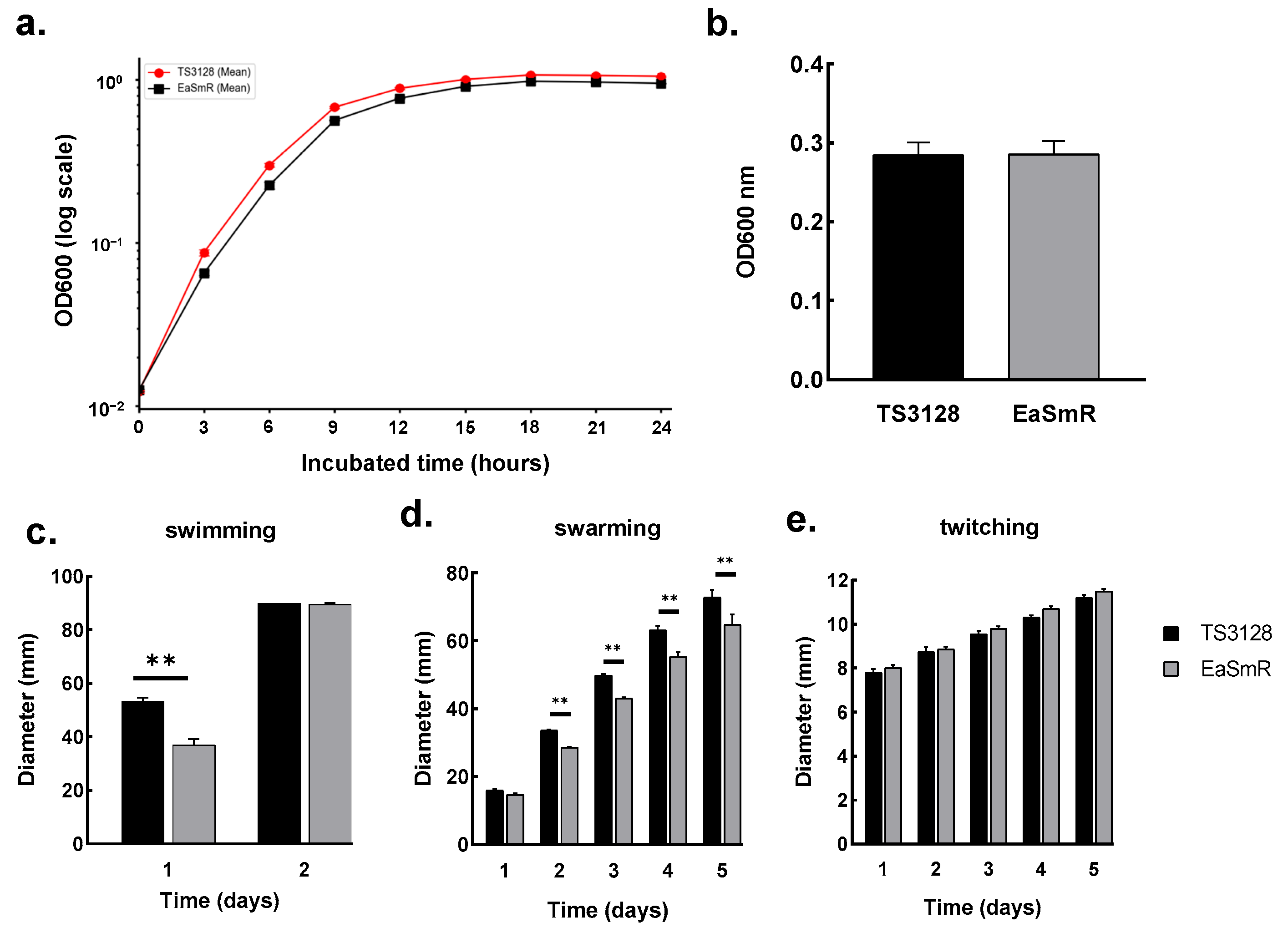
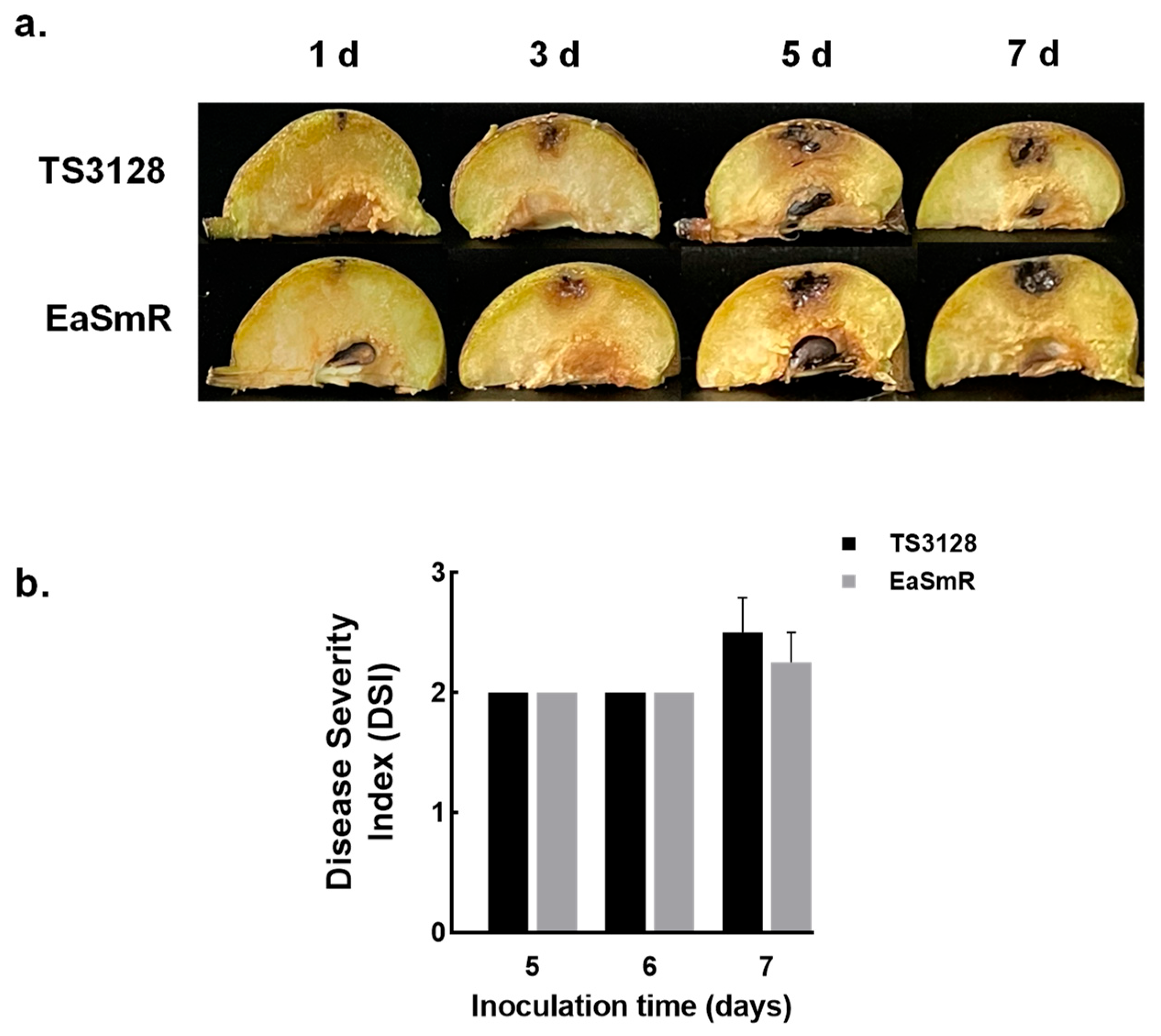
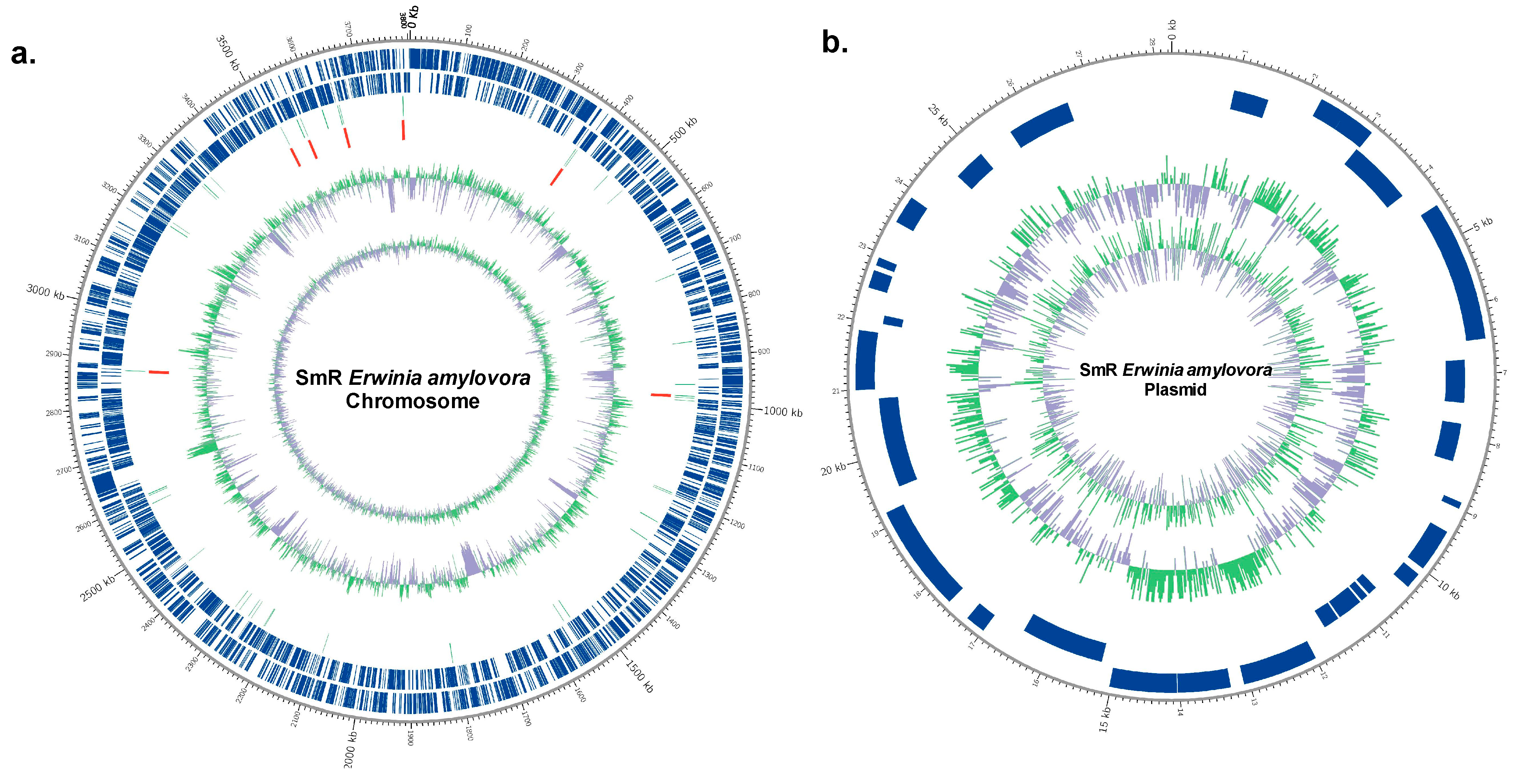
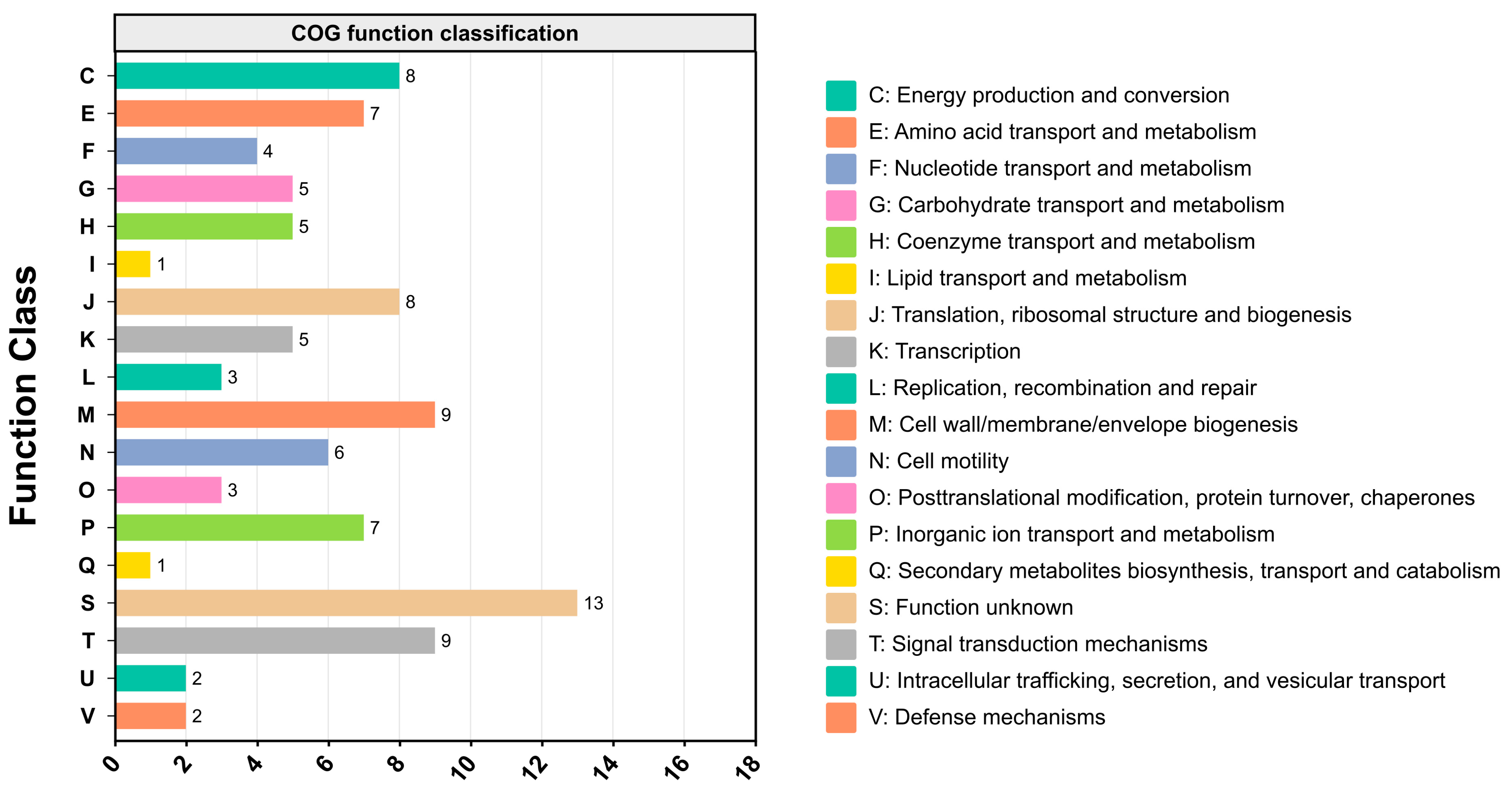
| Features | Statistics | |
|---|---|---|
| PacBio Sequel platform | ||
| Number of reads | 91,629 | |
| Total length of reads | 830,030,786 bp | |
| N50 length | 11,431 bp | |
| Average read length | 9058 bp | |
| Illumina NovaSeq platform | ||
| Raw data of length | 3,674,192,098 bp | |
| Clean data of length | 2,032,571,077 bp | |
| Raw data of read | 24,332,398 | |
| Clean data of read | 13,466,294 | |
| Clean data Q20 | 99.06% | |
| Clean data Q30 | 96.0% | |
| Clean data GC | 54.35% | |
| Genome assembly | Chromosome | Plasmid |
| Contig number | 1 | 1 |
| Circular | YES | YES |
| Contig size | 3,804,100 bp | 28,251 bp |
| GC content | 53.6% | 50.2% |
| Depth | 191.0× | 76.2× |
| Genome annotation | ||
| Putative protein-coding genes | 3371 | 30 |
| Number of tRNA | 78 | 0 |
| Number of rRNA | 22 | 0 |
| BUSCOs | ||
| Complete and single-copy BUSCOs | 124 (100%) | |
| Complete and duplicated BUSCOs | 0 (0.00%) | |
| Fragmented BUSCOs | 0 (0.00%) | |
| Missing BUSCOs | 0 (0.00%) | |
| Total BUSCO groups searched | 124 (100%) | |
| Gene ID | Name | Function Description | COG Cluster | Position in CDS | Amino Acid Changed |
|---|---|---|---|---|---|
| EAMY_3391 | rpsL | 30S ribosomal protein S12 | J | 129 | K(AAA)→N(AAC) |
| EAMY_0123 | emrD | multidrug transporter EmrD | E, G, P | 587 | S(TCT)→F(TTT) |
| EAMY_1008 | acrB | multidrug efflux RND transporter permease subunit | V | 932 | V(GTT)→G(GGT) |
| EAMY_2263 | yegN | multidrug transporter subunit MdtB | V | 2573 | A(GCC)→V(GTC) |
| EAMY_0777 | invG | EscC/YscC/HrcC family type III secretion system outer membrane ring protein | N, U | 71 | S(AGC)→I(ATC) |
| EAMY_2090 | tap | methyl-accepting chemotaxis protein | N, T | 832 | Q(CAG)→* (TAG) (Stop gained) |
| EAMY_2657 | tsr | methyl-accepting chemotaxis protein | N, T | 1579 | Q(CAG)→* (TAG) (Stop gained) |
Disclaimer/Publisher’s Note: The statements, opinions and data contained in all publications are solely those of the individual author(s) and contributor(s) and not of MDPI and/or the editor(s). MDPI and/or the editor(s) disclaim responsibility for any injury to people or property resulting from any ideas, methods, instructions or products referred to in the content. |
© 2024 by the authors. Licensee MDPI, Basel, Switzerland. This article is an open access article distributed under the terms and conditions of the Creative Commons Attribution (CC BY) license (https://creativecommons.org/licenses/by/4.0/).
Share and Cite
He, L.; Kim, Y.; Kim, S.; Lee, M.-H.; Yu, J.M. Unveiling Antibiotic Resistance: Genome Sequencing of Streptomycin-Resistant Erwinia amylovora Isolate. Microorganisms 2024, 12, 2494. https://doi.org/10.3390/microorganisms12122494
He L, Kim Y, Kim S, Lee M-H, Yu JM. Unveiling Antibiotic Resistance: Genome Sequencing of Streptomycin-Resistant Erwinia amylovora Isolate. Microorganisms. 2024; 12(12):2494. https://doi.org/10.3390/microorganisms12122494
Chicago/Turabian StyleHe, Lin, Yuna Kim, Seohyun Kim, Mi-Hyun Lee, and Jun Myoung Yu. 2024. "Unveiling Antibiotic Resistance: Genome Sequencing of Streptomycin-Resistant Erwinia amylovora Isolate" Microorganisms 12, no. 12: 2494. https://doi.org/10.3390/microorganisms12122494
APA StyleHe, L., Kim, Y., Kim, S., Lee, M.-H., & Yu, J. M. (2024). Unveiling Antibiotic Resistance: Genome Sequencing of Streptomycin-Resistant Erwinia amylovora Isolate. Microorganisms, 12(12), 2494. https://doi.org/10.3390/microorganisms12122494







